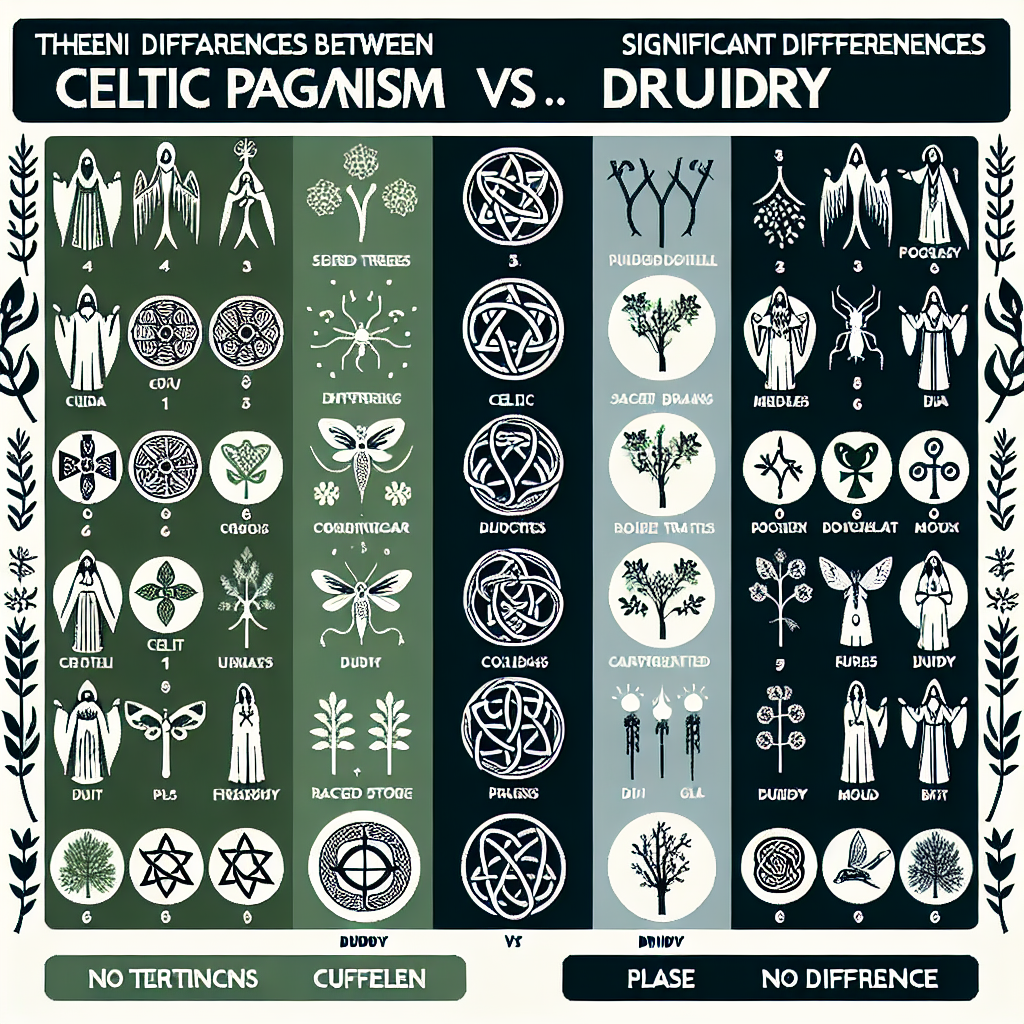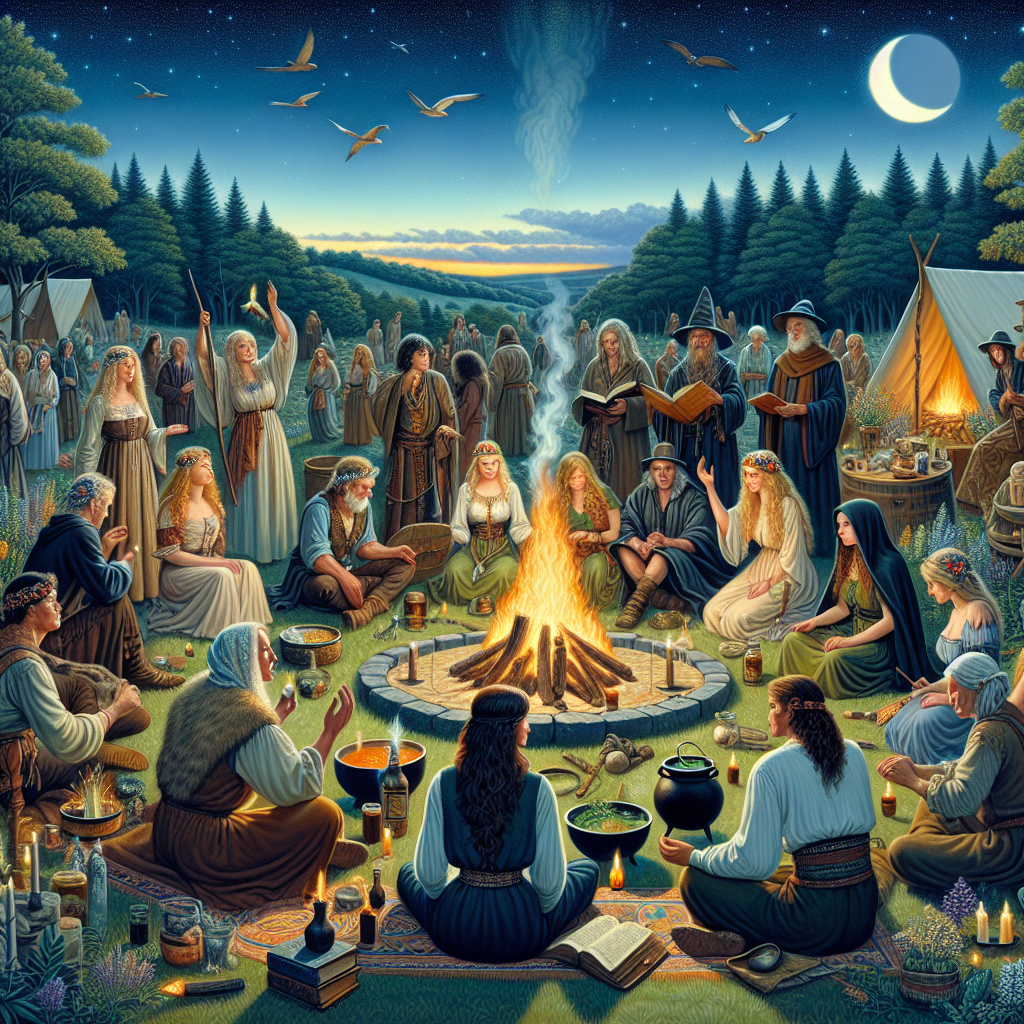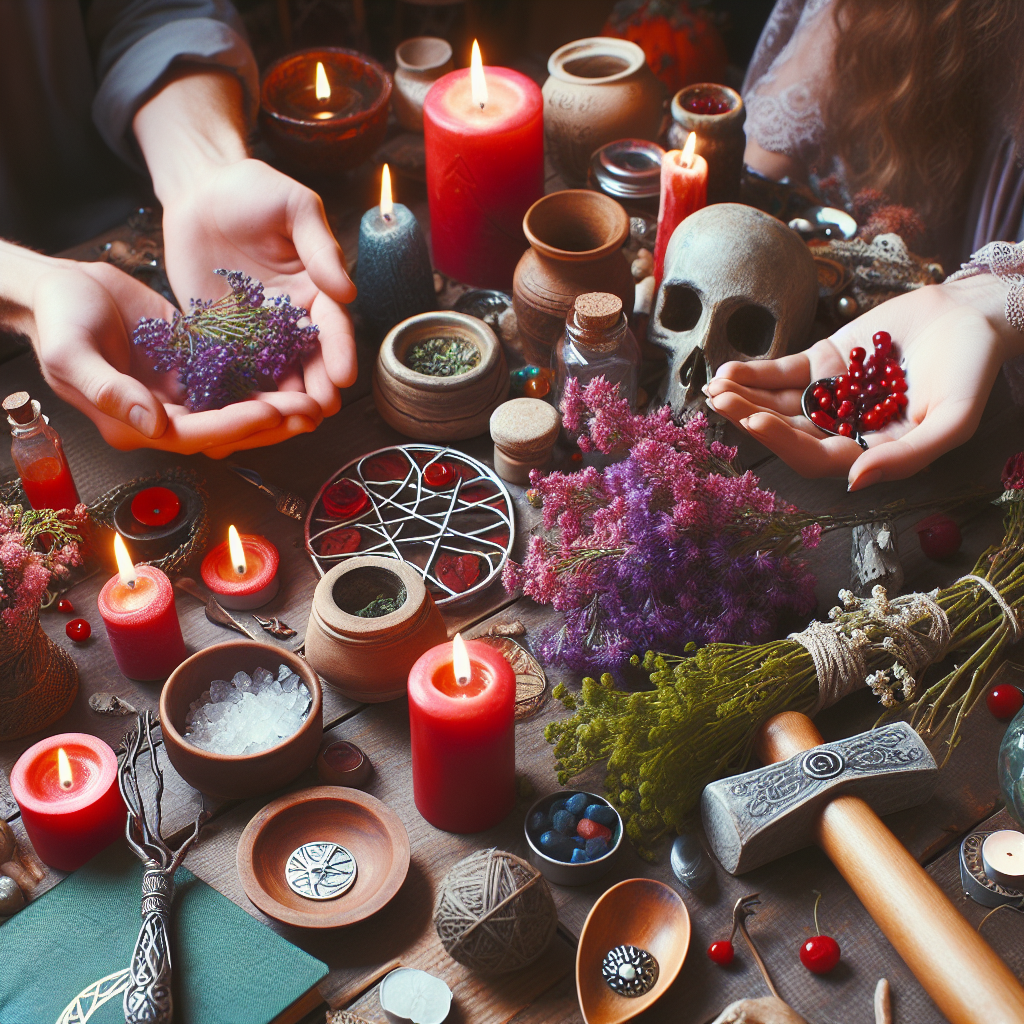As an Amazon Associate I earn from qualifying purchases.

u003cH2u003eCeltic Paganism and Druidry: A Distinct Explorationu003c/H2u003e
u003cH3u003eHistorical Roots and Beliefsu003c/H3u003e
Celtic Paganism traces its origins back to the Iron Age Celts who inhabited parts of Europe, while Druidry, which emerged around the same period, served as the spiritual and intellectual backbone of these societies. Both share polytheistic beliefs but differ in their central deities and mythological narratives. Celtic Paganism typically involves worshipping a broad pantheon of gods and goddesses such as Lugh, Brigid, and Cernunnos. In contrast, Druidry focuses on natural elements, the reverence of ancestors, and Earth-based spirituality, making it more animistic.
Celtic Paganism’s rich mythology often intertwines with local folklore and seasonal festivals. Druids, as the learned class of priests, judges, and lore-keepers, held significant sway in ancient Celtic societies. Modern Celtic Paganism often revives ancient rites, while contemporary Druid orders like the Order of Bards, Ovates & Druids (OBOD) emphasize personal spiritual development, ecological awareness, and community rituals.
u003cH3u003eRitual Practices and Ceremoniesu003c/H3u003e
Ritual practices in Celtic Paganism involve elaborate ceremonies that honor deities through offerings, feasts, and storytelling. Seasonal festivals like Samhain and Beltane are celebrated with detailed rituals that align with agricultural cycles and nature’s phases. Druidic rituals, while also marking seasonal changes, focus on meditative practices, poetic recitations, and symbolic gestures that connect practitioners to the spiritual energies of the earth, sea, and sky.
The sacred sites hold immense importance for both traditions but in varied forms. Celtic Pagans might convene at stone circles and ancient groves known to be power spots for invoking deities. Druids, however, place greater emphasis on natural environments like oak groves and open fields where the presence of natural spirits is believed to be stronger.
u003cH3u003eCommunity and Leadership Structuresu003c/H3u003e
Celtic Paganism commonly lacks a formalized structure, and leadership can vary greatly within local covens or tribal groups. This flexibility allows for a diversity of practices and beliefs to flourish under the broader umbrella of Celtic spirituality. Druids, however, traditionally follow a more structured approach, with clear distinctions between ranks such as Bards, Ovates, and Druids. Each rank represents a different level of knowledge and responsibility, and contemporary Druid groups continue to follow this hierarchical model.
The role of community differs significantly between the two. Celtic Paganism is often more individualistic or family-oriented, integrating personal rites with communal activities. Druidry emphasizes the collective wisdom of the group, often seen in their structured gatherings and seasonal assemblies. This creates a supportive spiritual community that promotes collective learning and mutual aid.
u003cH3u003ePhilosophical and Ethical Outlooksu003c/H3u003e
Celtic Paganism typically embraces a polytheistic worldview where multiple gods and natural forces influence the human experience. The ethical outlook is often centered around respect for nature, hospitality, and honoring ancestral traditions. Personal honor and bravery are also significant virtues, reflecting the martial culture of the ancient Celts.
Druidry’s philosophical outlook is closely tied to reverence for the earth, ecological sustainability, and inner wisdom. Ethical practices include a commitment to peace, balance, and the respectful use of natural resources. Many modern Druids adopt eco-friendly lifestyles and engage in environmental activism as extensions of their spiritual beliefs.
u003cH3u003eSymbolism and Artistic Expressionsu003c/H3u003e
The artistic expressions within Celtic Paganism are vibrant and diverse, often featuring intricate knotwork, depictions of legendary tales in carvings, and the use of symbols like the triple spiral and the Claddagh. These artistic forms celebrate the myths and legends, bringing the pantheon of gods and nature spirits into everyday life.
Druidry also employs rich symbolism but places a greater emphasis on natural elements such as trees, stones, and animals. The Awen symbol, representing the flow of inspiration, and the use of ogham (an ancient linear script), are significant in Druidic traditions. These symbols connect practitioners with the deeper truths and elemental forces of the world, encouraging a contemplative and harmonious lifestyle.
### 13 Differences Between Celtic Paganism and Druidry
**1. Historical Roots:**
Celtic Paganism encompasses the religious beliefs and practices of the ancient Celtic people, who lived across Europe from around 500 BCE to 500 CE. Druidry, on the other hand, is a spiritual and philosophical tradition that emerged within the context of Celtic society but evolved into a distinct path. Historical Druidry was practiced by a specialized class of religious leaders known as Druids within Celtic tribes.
**2. Deities and Pantheon:**
Celtic Paganism is polytheistic, featuring a wide array of deities like Lugh, Brigid, and the Morrigan. These gods are often tied to natural phenomena and human experiences. Druidry also acknowledges these deities but places a more focused emphasis on nature worship and the idea of divine interconnectedness within the environment.
**3. Role of Practitioners:**
In Celtic Paganism, anyone could participate in religious rituals and practices, often led by tribal elders or shamans. Druidry, however, was specific to a learned class known as Druids, who acted as priests, scholars, and judicial authorities. Today, modern Druidry is accessible to all who seek spiritual enlightenment.
**4. Common Pagan Rituals:**
Both traditions share common pagan rituals such as seasonal festivals, but the religious calendar in Druidry incorporates unique celebrations like Alban Arthan and Alban Elfed, which are solstice and equinox observances. Celtic Paganism aligns closely with traditional agricultural cycles like Imbolc and Lughnasadh.
**5. Witchcraft Practices and Magical Ceremonies:**
Celtic Paganism often integrates witchcraft practices and magical ceremonies such as divination, spell casting, and invoking the elements. Druidry incorporates similar magical elements but places a stronger emphasis on rituals that harmonize with natural cycles, focusing on spiritual growth and environmental stewardship.
**6. Written Texts and Oral Traditions:**
Celtic Paganism primarily relied on oral traditions to pass down its myths and religious guidelines. Modern interpretations are often based on later written accounts, archeological findings, and folk traditions. Druidry in ancient times also emphasized oral transmission, with bards playing a key role in preserving knowledge. Contemporary Druidry has established bodies of written work, including the teachings of influential figures like Ross Nichols.
**7. Community and Social Structure:**
Celtic Paganism operated within a tribal system where religious practices were community-based. Druidry was more hierarchical, with Druids enjoying high social status and forming an intellectual elite within the tribe. Nowadays, Druidry tends to be more egalitarian, with various orders and groups based on shared pursuits and community goals.
**8. Environmental Connection:**
Both traditions emphasize a strong connection to nature, but Druidry places this at the forefront of its practice. Modern Druids often engage in environmental activism and conservation work as a spiritual obligation. In Celtic Paganism, nature is revered and appeased through rituals and offerings, acknowledging the sacred in everyday life.
**9. Sacred Spaces:**
Celtic Paganism often uses natural locations like groves, springs, and hilltops for worship, considering these spaces intrinsically sacred. Druidry also uses such natural settings but often incorporates constructed elements like stone circles and altars. Modern Druids create sacred spaces that blend seamlessly with their natural surroundings.
**10. The Role of Mythology:**
In Celtic Paganism, mythology plays a central role in explaining the world and informing religious practices. Stories of gods, heroes, and mythical creatures guide moral and practical life. Druidry uses mythology as a tool for teaching and spiritual exploration, often reinterpreting myths to extract deeper meanings and contemporary relevance.
**11. Divination and Prophecy:**
Divination is a common feature in Celtic Paganism, utilizing methods like Ogham sticks, rune casting, or examining natural phenomena. Druids historically served as seers, providing counsel through complex forms of divination. Modern Druidry continues this practice, often with a philosophical approach toward prophecy and spiritual insight.
**12. Ethical and Philosophical Frameworks:**
Celtic Paganism bases its ethical structure on tribal laws, communal welfare, and reciprocity with the divine. Druidry, while sharing these ethical principles, introduces a distinct philosophical framework that emphasizes wisdom, creativity, and a harmonious relationship with the natural world. This distinction is often reflected in modern Druidic teachings and literature.
**13. Modern Evolution and Practice:**
Celtic Paganism has influenced various modern pagan paths, including Wicca and eclectic witchcraft, which incorporate elements like nature worship and magical practices. Druidry has also evolved, with numerous organizations and individuals dedicating themselves to its revival. Modern Druidic practice often involves rites of passage, meditation, and environmental advocacy, distinguishing it from the broader categories of Celtic-inspired spiritualities.
Recent surveys indicate that approximately 1.5 million people globally identify with neopagan beliefs, within which Celtic Paganism and Druidry play significant roles.
Spiritual Focus
In my journey with Celtic Paganism, I noticed the significance placed on the worship of deities like Lugh, Brigid, and The Morrigan. These gods and goddesses provided a rich tapestry of myths and legends that guided my spiritual practices and rituals. The stories of these deities informed my understanding of sacred natural sites and seasonal festivals, making each celebration deeply meaningful.
My experience with Druidry, on the other hand, emphasized a broader spiritual focus that wasn’t limited to specific gods and goddesses. Druids spoke more about the interconnectedness between nature, the cosmos, and the self. Unlike Celtic Paganism, which had a clear pantheon, Druidry seemed to have a more philosophical and nature-oriented approach. I felt a deeper connection to the natural world and an awareness of the spirits of the land, water, and trees.
Both paths brought me closer to nature, but in unique ways. While Celtic Paganism gave me a structured way to honor specific deities during festivals, Druidry opened my eyes to the sacredness of everyday experiences and the importance of balance and harmony in the natural world.
Ritual Practice
Participating in Celtic Pagan rituals often involved a mixture of offerings and prayers dedicated to the gods and goddesses. I remember participating in a Lughnasadh festival where we offered the first fruits of the harvest to Lugh. Each ritual had a clear purpose and followed traditional guidelines that had been handed down through generations.
In contrast, the rituals I experienced in the Druidic tradition felt more spontaneous and focused on personal experience. For example, during a Samhain gathering, the emphasis was on meditation and connecting with ancestral spirits rather than performing set rituals for specific deities. The experience was more introspective, aimed at personal growth and learning from the past rather than seeking favor from gods.
Though different, both ritual practices enriched my spiritual life. The structured rituals of Celtic Paganism brought a sense of continuity and connection to ancient traditions, while the fluid, meditational practices of Druidry allowed me to explore my inner self and my personal relationship with the natural world.
Community and Solitary Practices
Celtic Paganism, in my experience, often involved group rituals and festivals that brought the community together. These gatherings were vibrant, filled with song, dance, and shared meals. Being part of these large communal ceremonies created a strong sense of belonging and mutual support. I always looked forward to these events as they reinforced our collective bond and cultural heritage.
When practicing Druidry, however, I found that while there were community gatherings, there was a significant emphasis on solitary practice. Many rituals were designed to be performed alone, in nature, allowing for a personal and introspective experience. I spent many mornings greeting the sunrise alone, reflecting on the elements and their influence on my life.
This blend of communal and solitary practices provided me with a balanced spiritual experience. The communal aspects of Celtic Paganism grounded me in my cultural roots and provided social support, while the solitary practices of Druidry allowed me to cultivate a personal, reflective relationship with the natural world and my spiritual path.
Use of Sacred Spaces
In Celtic Paganism, sacred spaces often included ancient sites like stone circles, sacred wells, and groves dedicated to specific deities. These locations had historical significance, and rituals performed there felt imbued with the energy and legacy of the ancestors. Visiting these sites during seasonal festivals gave me a profound sense of stepping into a timeless tradition.
The Druidic use of sacred spaces, while also valuing ancient sites, emphasized the sacredness of any natural environment. I learned that a simple forest clearing or a quiet riverbank could become a sacred space. My Druidic mentors taught me to commune with the spirits of these places and honor their energy, irrespective of historical significance.
This approach profoundly changed how I perceive and interact with the environment. While I still cherished the historically significant sites from my Celtic Pagan practices, I also developed a deep respect for everyday natural spaces as sacred. This led to a more holistic and integrated spiritual life, where the sacred was not confined to specific, historically important areas but could be found anywhere in the natural world.
1. What are the main differences between Celtic Paganism and Druidry?
Celtic Paganism is a broad term that encompasses various spiritual practices, rituals, and beliefs rooted in ancient Celtic cultures. Druidry, on the other hand, is a specific path within Celtic Paganism that focuses on the roles of Druids as religious leaders, scholars, and mediators between the spiritual and natural worlds. While there can be overlap, not all Celtic Pagans identify as Druids.
2. Are the rituals in Celtic Paganism and Druidry similar?
While there are similarities, rituals in Celtic Paganism and Druidry can vary significantly. Celtic Pagan rituals often emphasize a connection to the land, seasonal cycles, and deities specific to Celtic traditions. Druidic rituals may also include these elements but focus more on the roles and responsibilities of the Druids, including rites of passage, divination, and peacekeeping ceremonies.
3. Is witchcraft practiced in both Celtic Paganism and Druidry?
Witchcraft can be a part of both Celtic Paganism and Druidry, but it is not a necessity for either. Some individuals who follow these paths may engage in witchcraft, while others may not. The practice of witchcraft in these traditions often involves spellcasting, herbalism, and a deep understanding of natural cycles.
4. What types of magical ceremonies are performed in Celtic Paganism?
Magical ceremonies in Celtic Paganism can include rites to honor the deities, seasonal festivals like Samhain and Beltane, and personal rituals such as blessings or divination. These ceremonies often involve offerings, chanting, and the use of sacred symbols and tools like the cauldron and the wand.
5. How do spiritual routines differ between Celtic Paganism and Druidry?
Spiritual routines in Celtic Paganism might focus more broadly on personal or communal interaction with nature, the ancestors, and the gods. Druids specifically often follow a more regimented practice that includes study, meditation, and community service. The routines of Druids might also include specific rites and responsibilities unique to their role.
6. What shared traditions exist between Celtic Paganism and Druidry?
Both Celtic Paganism and Druidry share a reverence for nature, the cycles of the seasons, and the importance of community. Festivals like Imbolc, Lughnasadh, Samhain, and Beltane are observed in both traditions. They also share a common ancestry of myths and legends from the Celtic cultural heritage.
7. How do common pagan rituals manifest in Druidic practice?
In Druidic practice, common pagan rituals are often carried out with a specific structure and purpose reflective of the Druid’s role. This might include rituals to honor the spirits of the land, to mediate disputes, or to conduct seasonal ceremonies with a scholarly precision and focus on traditional lore.
8. Do Druids utilize the Wheel of the Year like other Celtic Pagans?
Yes, Druids observe the Wheel of the Year, celebrating the same eight major festivals as other Celtic Pagans. These include the solstices, equinoxes, and the midpoints between them. However, the complexity and formality of these celebrations might be more pronounced in Druidic practice, involving more detailed rites and invocations.
9. Is there a specific pantheon of deities worshipped in Druidry compared to Celtic Paganism?
Both traditions have a common pantheon derived from Celtic mythology, including gods like the Dagda, Brigid, and Lugh. However, Druids might emphasize different aspects of these deities or invoke them for more specialized purposes such as healing, poetry, or wisdom. Some Druids might also have more scholarly or historical interpretations of these deities.
10. How do Druidic healing practices compare to those in broader Celtic Paganism?
Healing practices in Druidry often involve a combination of herbal knowledge, ritual, and spiritual guidance. Druids might employ specific blessings or ceremonies to aid in healing, drawing on their deeper understanding of herbal lore and the spiritual needs of the patient. In broader Celtic Paganism, healing practices may also use herbs and rituals but might be more varied and less structured.

## Conclusion
The distinctions between Celtic Paganism and Druidry lie in their varying emphasis on rituals, practices, and spiritual frameworks. Celtic Paganism tends to incorporate a broader array of common pagan rituals, including those associated with witchcraft practices and magical ceremonies. These rituals often entail invoking a pantheon of deities and harnessing natural elements to align with the cycles of the earth. In contrast, Druidry is typically more structured, with a stronger focus on the roles of nature and ancestors, and does not emphasize witchcraft practices to the same extent. Druidic practices are deeply rooted in oral traditions, meditation, and communal ceremonies that often revolve around seasonal festivals.
Both spiritual paths share certain traditions and spiritual routines, such as reverence for nature, but their methods and focal points differ markedly. Celtic Paganism may incorporate eclectic and diverse spiritual routines, influenced by various pagan and neo-pagan practices. Meanwhile, Druidry adheres more closely to historically influenced rites and teachings, aiming to restore and preserve ancient Celtic wisdom. These differences underscore how each path offers a distinct spiritual journey through their unique lenses on shared themes of nature worship, ritualistic practices, and community engagement. Understanding these nuances can help individuals better align with the spiritual path that resonates most deeply with their personal beliefs and practices.
Amazon and the Amazon logo are trademarks of Amazon.com, Inc, or its affiliates.


